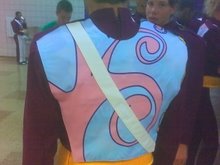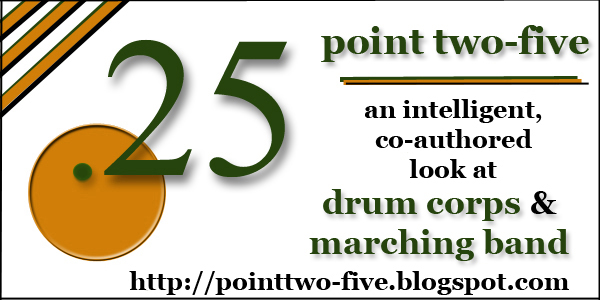The Cavaliers (Rosemont, Ill.)
The Cavaliers white collared green top and black pants provide a stark counterpoint to the Cadet's "West Point" uniforms. As different as the uniforms are now, The Cavaliers original uniforms have a similar design legacy to the Cadets. The original uniforms were khaki affairs complete with shoulder braids reminiscent of military stylings. New uniforms were purchased from Army surplus stores in blue of all colors, then the following year, new uniforms yet again. These uniforms resembled more the style associate with the Cavaliers today, save for the shako and cummerbund. The "Cavalier" hat was first worn by the corps in 1976. The shape and height of the crown of the hat is different from an Aussie.Variations of the '76 uniform were worn through 1983. The first edition of the current uniform was worn in 1984. (thanks j_paul!) These uniforms assist the Cavaliers in executing a completely different visual style than The Cadets.
 The short jacket and absence of a cummerbund obscure a good portion of the performers' figure beneath a shroud of dark material. This brings the viewer's focus to the top third of the body. The uniforms are designed just the opposite of the Cadets' - not only is the focus entirely on the upper body, but the white "wing" elements on the shoulder serve to broaden the upper body, building a strong horizontal presence. The sash is even curved a bit in a downward sweep, minimizing any height drop. The entire Cavalier visual program is based around this premise of horizontal over vertical. When horns are in playing position, the imposing nature of their posture arises, not from height, but from this broad encompassing stature.
The short jacket and absence of a cummerbund obscure a good portion of the performers' figure beneath a shroud of dark material. This brings the viewer's focus to the top third of the body. The uniforms are designed just the opposite of the Cadets' - not only is the focus entirely on the upper body, but the white "wing" elements on the shoulder serve to broaden the upper body, building a strong horizontal presence. The sash is even curved a bit in a downward sweep, minimizing any height drop. The entire Cavalier visual program is based around this premise of horizontal over vertical. When horns are in playing position, the imposing nature of their posture arises, not from height, but from this broad encompassing stature.
The lower body being shrouded in a vague, dark mass makes it easy for the Cavaliers to pull off their signature "Bicycle" marching style. The style involves significant leg motion and knee bend to achieve. Since the uniform is not dependent upon a stature of height, the drastic height changes associated with this style of marching become less noticeable and less offensive to the eye. Timing and spacing errors also become less obvious due to less contrast between the black pants and the green field. The use of this style of marching makes possible many swift moves that would prove to be almost prohibitively challenging to the straight legged corps.
The upper body is clearly contrasted through the use of a white collar, white "wings", a white sash, white gauntlets and white gloves. These aspects of the uniform are seen to move smoothly across the field - to "float" if you will. It is these elements that make up the forms of the drill. The audience doesn't see a tall thin figure (as with the uniforms of The Cadets), but instead, a figure almost wider than it is in height. It is almost as if there are little white rectangles (or more accurately, triangles) moving around the field at a very quick pace, forming pictures and developing forms.
The Cavaliers visual staff makes full use of this visual aspect of the uniforms. More often than not, visuals involve the upper body creating motion. This is most clearly seen in "Machine" near the beginning when the trumpets move into two huge vertical lines . The visual is one where the upper body is tilted to the left and right, alternating every other person (sorry, I cant find my video or I would give you a time marker). This works only due to the uniforms and the visual spectacle they create.
Thats all for right now...tomorrow, The uniforms of the Blue Devils
Continue reading...
The "inspired by Star Trek" look works well for Southwind who has not had th best luck in uniform selection over the past couple years. The return to the traditional shako and plume is a safe choice and the simplified colors and cut to the uniforms make the corps look more cohesive as a unit. There is some visual distinctiveness as it is very apparent when parts of the corps are turned backfield. The yellow and white on the shoulders serves well to highlight front facing performers.

